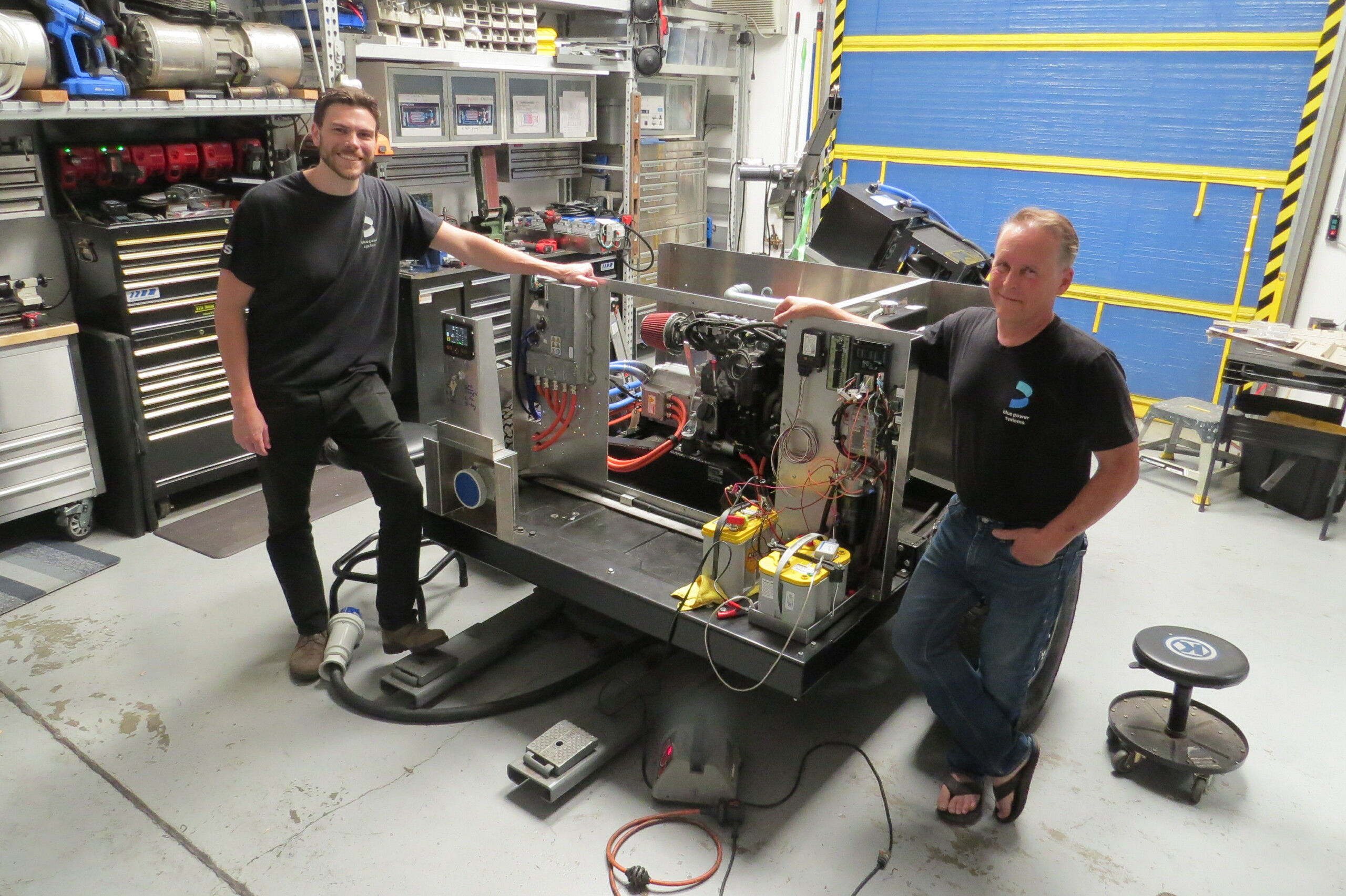Business profile: Blue Power team develops innovations in clean energy storage
South Valley start-up seeks to provide clean energy with diesel backup to off-grid homes, facilities
![]()

Photo by Marty Cheek
From left: Greg Miller, Blue Energy Systems development specialist; and Ray Caamano, CEO and president, with a next-stage prototype of their energy storage system using lithium batteries.
By Calvin Nuttall
Forget noisy, inefficient diesel generators. Thanks to a South Valley-based startup, the future of off-grid living may soon get a whole lot quieter and smarter.
 Energy storage company Blue Power Systems aims to provide an all-in-one power grid in a small and mobile package the size of a small trailer. Located in a garage workshop of a home off Mount Madonna Road, the company’s small team of techies has engineered what could one day be a cutting-edge renewable energy product.
Energy storage company Blue Power Systems aims to provide an all-in-one power grid in a small and mobile package the size of a small trailer. Located in a garage workshop of a home off Mount Madonna Road, the company’s small team of techies has engineered what could one day be a cutting-edge renewable energy product.
They’re building prototypes of a seamless integration of lithium battery storage, solar panels or wind turbines, and backup generation from renewable diesel for those cloudy days. Their mobile, networked units think for themselves, chat with each other, and sip fuel only as needed to keep homes humming come rain, shine or PG&E outage.
“It’s a hybrid paradigm which gives you the best of both worlds,” said Greg Miller, Blue Power’s business development specialist. “Battery systems are often connected to solar, but solar is not always available. In order to prevent the battery from going offline, you have to be able to recharge the battery somehow. If the sun isn’t out, how are you going to do that?”
To answer this question, the Blue Power team integrated a large battery with their patented onboard power generation system. It directly charges the battery as needed when renewable energy is not available. In the case of their latest prototype, the backup power comes from a diesel engine which draws from an onboard fuel tank.

Photo by Marty Cheek From left: Greg Miller, Blue Energy Systems development specialist; and Ray Caamano, CEO and president, with a unit of their mobile energy storage system using lithium batteries.
“For this prototype we’re using a renewable-diesel engine, which is a great fuel comprised of 95 percent recycled animal and plant fats and is readily available,” Miller said. “But it could easily be a propane or natural gas engine. It is really based on the needs of the customer.”
This integrated system is more efficient than using a traditional generator. Rather than running a generator continuously in order to provide power to an off-the-grid home or facility, the generator only runs when power stored in the battery needs to be replenished.
“It’s like filling up your water tank and then shutting it off, rather than having a constant waterfall and filling up a little cup when you need it,” Miller said. “You’re wasting so much. This usually gives around eight-and-a-half times fuel use and emissions reductions on average. And, of course, this is hybridized with renewable energy.”
President and CEO Ray Caamano pointed out the feature that sets their system apart from others is its ability to independently monitor itself and network with other units to manage power availability in a micro-grid.
“These are all intelligently linked together,” he said. “It is thinking for you. Any time a unit might need servicing, or oil, a new air filter, refueling, etc., it’s going to tell you.”
Between the battery and fuel tank, the system stores one megawatt-hour of energy, enough to power the average American home for more than a month. Operating as an energy reservoir and backup generator to a solar- or wind-based system, it could potentially last many more months, providing consistent power around the clock.
 “You hedge your bets by having a combination of different power sources,” said Alex Rubin, an investor in Blue Power who is closely involved with the project. “There are a lot of moving parts, and there is a lot of energy balancing for optimization.”
“You hedge your bets by having a combination of different power sources,” said Alex Rubin, an investor in Blue Power who is closely involved with the project. “There are a lot of moving parts, and there is a lot of energy balancing for optimization.”
The system keeps the battery healthy by carefully controlling its charge state and temperature. These measures help the battery last years longer than similar batteries used in more strenuous applications, such as electric vehicles, which are charged and discharged constantly.
“They have integrated all of that into a collection of controls that make it, from a user’s standpoint, very simple. Basically plug-and-play,” Rubin said. “The genius of what Ray has done is to draw the best from different industries and leverage those technologies to make a better product at a collective level.”
Caamano’s whole-system perspective comes from his experience managing energy storage and propulsion systems while working on electric vehicle projects. His first foray into the field came in the 1990s working on an experimental solar-power race car called Afterburner, built by Stanford University to participate in the Sunrayce competition.
From there, Caamano developed a novel magnetically-driven electric motor design while working for KLD Energy. The motors were integrated into a fleet of delivery motorbikes sold in Malaysia.
“They use an extremely efficient magnetic material that is still not widely used in motors even today,” he said. “That system now has 15 million miles on it and is probably the lowest cost-per-mile vehicle ever created. They have no gearbox, it’s just a magnetic drive, so there is less loss of energy, and no wear in parts.”
From this expertise emerged an idea to apply the lessons learned in the EV industry to tackle a new problem — and thus Blue Power Systems was born.
“My background gave me a view of all these systems, because I have had to manage all the individual components in the past,” Caamano said. “I know how they work together. This system is essentially an electric vehicle propulsion system we’ve reversed, with the motor being used as an alternator.”
The team envisions a variety of potential applications. Remote communities serviced by long transmission lines are often in danger of their power being interrupted by storms or shut down due to fire danger. In such cases, a Blue Power unit could provide backup power for homes, or even neighborhoods with multiple units.
“When you’re in a vulnerable population, this is a great solution,” Miller said. “That’s really what this technology is aimed at.”
The flexibility afforded by the system’s mobility could also allow emergency services to move units to where they are needed in the event of power failures. In a future where self-driving vehicles roam the streets, units could even relocate themselves automatically in response to real-time power needs.
Meanwhile, homes and businesses can be free to be established in areas not serviced by transmission lines.
“Let’s say you wanted to buy a property but there are no power lines to it,” Caamano said. “You could drag one of these behind your pickup and have everything you’d ever need with a few solar panels.”
As a self-described “startup in stealth mode,” Blue Power has been keeping a low profile while it developed its first prototype. Its unique storage technology powers the company’s workshop. As their system approaches maturity, the company hopes to find investors to fund their next stage and start licensing their patented energy storage technology.
Calvin Nuttall is a Morgan Hill resident and freelance reporter.
